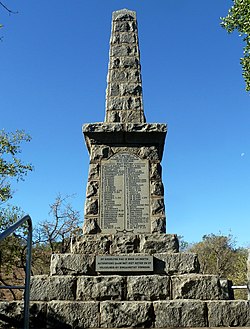Draft:Agterryer
 | Review waiting, please be patient.
This may take 8 weeks or more, since drafts are reviewed in no specific order. There are 2,842 pending submissions waiting for review.
Where to get help
How to improve a draft
You can also browse Wikipedia:Featured articles and Wikipedia:Good articles to find examples of Wikipedia's best writing on topics similar to your proposed article. Improving your odds of a speedy review To improve your odds of a faster review, tag your draft with relevant WikiProject tags using the button below. This will let reviewers know a new draft has been submitted in their area of interest. For instance, if you wrote about a female astronomer, you would want to add the Biography, Astronomy, and Women scientists tags. Editor resources
Reviewer tools
|
An Agterryer (lit: after-rider) were indigenous South African auxiliaries who voluntarily or involuntary accompanied Boers onto the battlefield in supportive roles such as cart drivers, horse grooms, cattle drivers, cooks, etc. during the Xhosa Wars, the First Boer War, and the Second Boer War. Agterryers did not typically server in a combat role.
Etymology
[edit]
The Afrikaans word agterryer was likely developed from the Dutch word achter rijder (rear-rider/ after-rider), a role which was typically reserved for a military servant or batman (aide) while serving in the military. According to the Dictionary of South African English an agterryer "In historical contexts. A mounted groom or other attendant; a military servant, or batman".[1]
According to William John Burchell in his book Travels in the Interior of South Africa printed in 1824:
"These achter-ryders are servants intended both for outward show and for use, and correspond in this twofold nature of their duty, to many of our English grooms. A colonist generally takes with him a Hottentot of this description, when he undertakes a journey to any considerable distance from home: and near the borders, such an attendant is far from useless, as he ensures to him some additional safety".[2]
Use in the Boer Wars
[edit]During the First Boer War and Second Boer War agterryers were used in a large capacity, some estimates reporting upwards of 2,000 servants were used during the war in various capacities.[3] According to Nosipho Nkuna of the South African Military History Society:
"Agterryers were either conscripted by the Boers or joined the commandos voluntarily. The Boers utilized agterryers for guarding spare ammunition, looking after the horses, cooking, collecting firewood and loading firearms. Not only were auxiliaries used in a labour capacity, but they were also used in fighting. Some photographs of Boer commandos and their agterryers attest to the fact that auxiliaries were armed during the war. Some of the Boers had a very strong attachment to their servants who had served them before the commencement of the war. Fransjohan Pretorius worked out the numeric ratio and concluded that a ratio of 1:4 or even 1:5 (agterryer pro rata to Boers) may be taken as realistic. Pretorius has suggested that roughly 15 000 agterryers served in the war. In his diary, C. A. Cronjé wrote about his agterryer, Kleinbooi Sabalana, and confirmed that he was given a rifle and fought in many battles. Keinbooi was only 15 years old when he joined the commandos, but proved himself to be brave in these battles".[4][5]
Legacy
[edit]
Several monuments commemorating agterryers and their service during the Great Trekand the Boer Wars exist in South Africa, namely at the Anglo-Boer War Museum in Bloemfontein, which was erected in 2013, as well as the Moordkoppie Monument located in Dingaanstat which commemorates the Piet Retief Delegation massacre.[3]
References
[edit]- ^ "agterryer - DSAE". dsae.co.za. Retrieved 2025-09-16.
- ^ Burchell, William J. (1824). Travels in the interior of Southern Africa. London: Longman, Hurst, Rees, Orme, Brown, and Green. p. 132.
- ^ a b Beeld. "Beeld : Agterryers kry eerste beeld". Beeld. Archived from the original on 2014-07-14. Retrieved 2025-09-17.
- ^ "Black involvement in the Anglo-Boer War, 1899-1902 - South African Military History Society". samilitaryhistory.org. Archived from the original on 2014-12-15. Retrieved 2025-09-17.
- ^ Nasson, Bill (1991). Abraham Esau's war : a Black South African war in the Cape, 1899-1902. Cambridge: Cambridge University Press. p. 94. ISBN 978-0-521-38512-1.